This has become a habit of mine, to look back at photos I took three years ago. It may be boring to some, but it helps me to remember the good times past and anticipate the sights which may greet us this October as we venture out into Illinois parks and back to our south Florida Everglades remnant preserve, our "Wounded Wetland."
To add some interest to my quest, I will try to include some favorite memes-- wild critters (especially birds), skies, reflections, fences, signs of the season, and scenes which speak for themselves.
We spent the first three weeks of October, 2014 at our second home in NE Illinois, missing the best of south Florida's warbler migration but enjoying the clear weather and cool temperatures. (This year we plan to get back to Florida a week earlier to celebrate the Quinceañera of the daughter of our son-in-law's first cousin in Miami.)
Lippold Park, in Batavia, IL was adorned in fall colors:

We got to welcome some winter birds, many of which do not visit south Florida. Yellow-rumped warblers arrived early in the month. In Florida they are among the last to appear and signal the end of warbler migration:
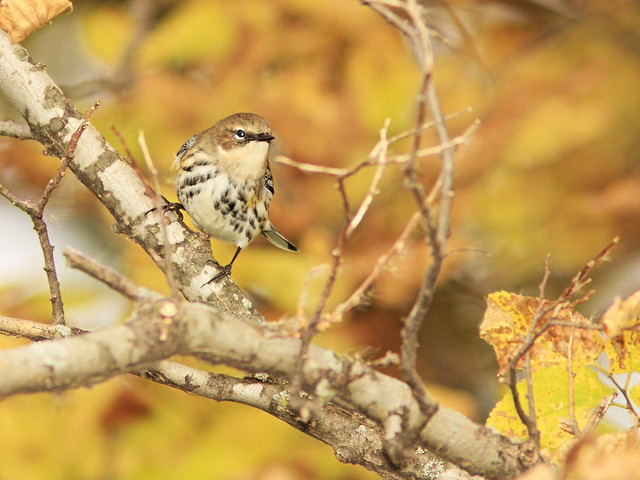
White-throated Sparrows had arrived from northern breeding grounds:


White-crowned Sparrows visited our daughter's feeders and rested on the deck railing. This is an adult:

First-year White-crowned Sparrows have brown and dull gray rather than black and white head stripes:
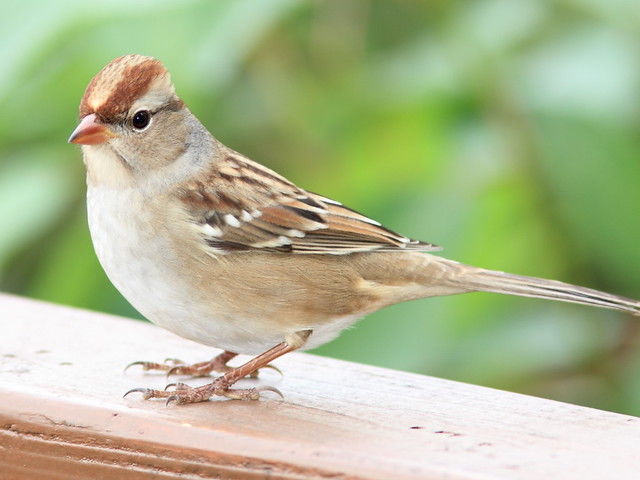
Ruby-crowned Kinglets appeared. In Florida we may see one or two some winters:

White-breasted Nuthatches are Illinois residents and are seen all winter, but they do move erratically southward and may be replaced by migrants or wanderers from the north. Few make it into south Florida:
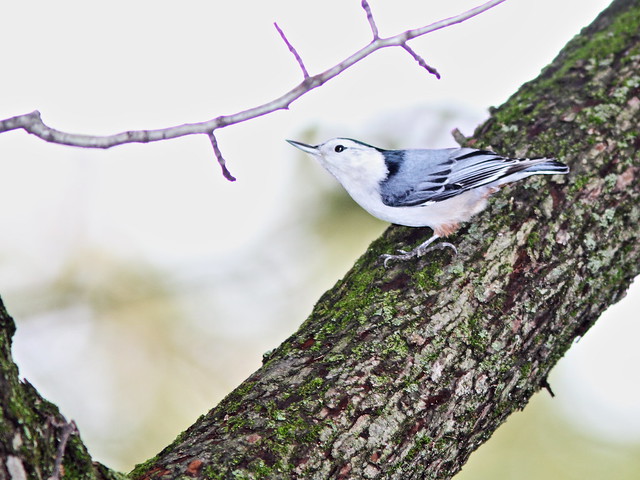
Black-capped Chickadees were abundant. This is another resident species which may wander about unexpectedly in some winters. A very similar relative, the Carolina Chickadee, ranges into central Florida:

Canada Geese were moving south. Note the similar but much smaller Cackling Geese in the foreground:

On October 22 we encountered our first flock of Purple Finches. This is a female:
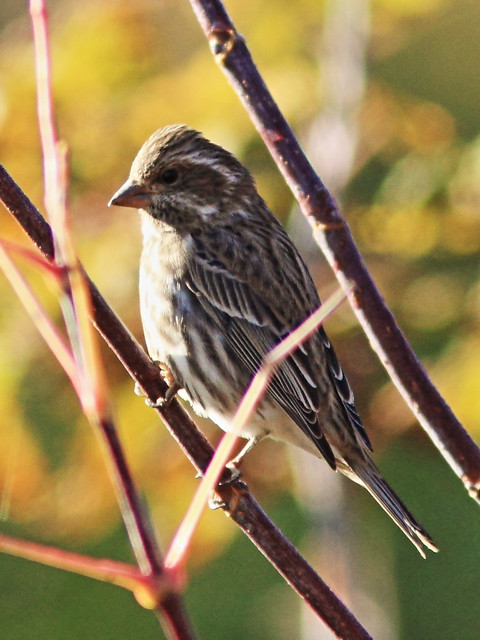
After breeding season, American Goldfinches change from bright yellow into more somber garb:

Before departing for Florida we spent a long weekend of fun with our daughter and family at Sturgeon Bay in Door County, Wisconsin. It is located in far NE Wisconsin and straddles both sides of the inlet between Lake Michigan and Green Bay. Our lodge was on the waterfront and we enjoyed beautiful sunsets:

Sturgeon Bay Marina:

Beautiful split-rail fence at "The Farm" in Door County:

It was much colder up in Wisconsin:

October 26 found us back in Florida. We were out early the next morning and captured this Great Egret before sunrise as it lifted off:
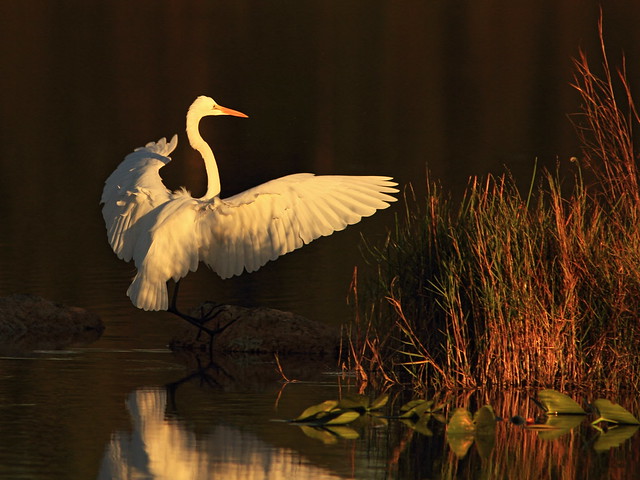
While visiting Chapel Trail Nature Preserve I obtained this unusual photo of a pair of Purple (Gray-headed) Swamphens reflecting in the lake:
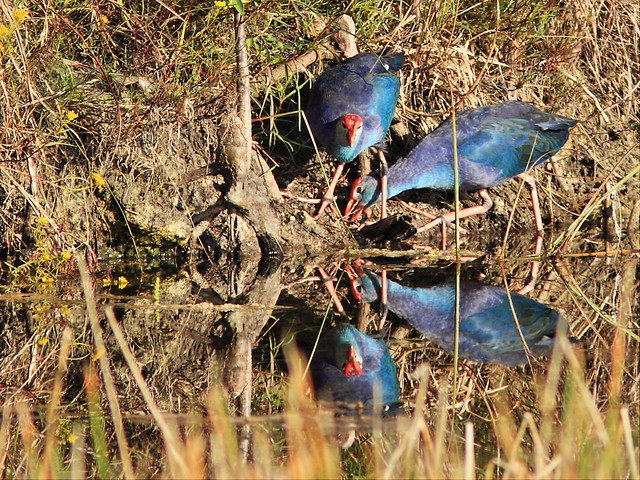
A Cattle Egret hunted for insects on a cow's back in the pasture next to Chapel Trail:
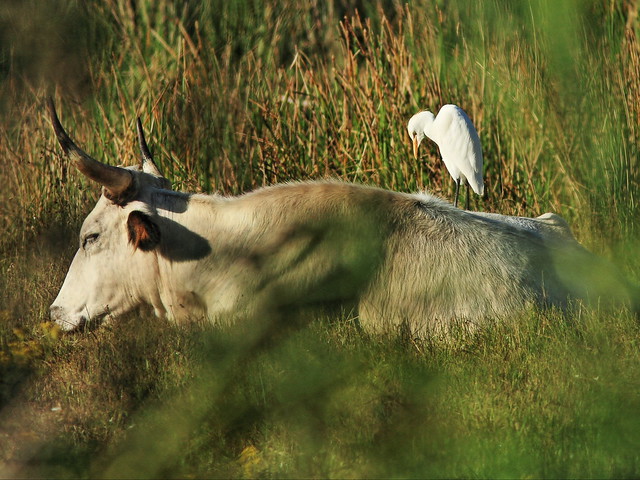
Sadly, on October 30 I saw our local female Bald Eagle "Joy" for the last time before she disappeared and was never seen again. She was sitting rather deep in the nest, rearranging sticks while her mate "Pride" stood by:
 = = = = = = = = = = = = = = =
= = = = = = = = = = = = = = =
Linking to Misty's CAMERA CRITTERS,
Linking to Eileen's SATURDAY'S CRITTERS,
Linking to FENCES AROUND THE WORLD by Gosia
Linking to SKYWATCH FRIDAY by Yogi, Sylvia and Sandy
Linking to WEEKEND REFLECTIONS by James
Linking to BirdD'Pot by Anni
Linking to Wild Bird Wednesday by Stewart
Linking to Wordless Wednesday (on Tuesday) by NC Sue
Linking to ALL SEASONS by Jesh
________________________________________________
Please visit the links to all these memes to see some excellent photos on display
________________________________________________
Located along the eastern shore of the Fox River in Batavia, Illinois, Lippold Park can be a very productive birding destination. A popular bike path runs along its outer perimeter. When we first visited the park back in 2008 the area was relatively undisturbed and included prairies, woodlands, a marsh and pond. The dirt paths were sometimes muddy and not maintained.
I was disappointed when land was cleared and the area near the entrance was torn up. Over the months an old maintenance shed was demolished and a pavilion was constructed. It included an elevated walkway which provided views of birds at tree-top level. Trails were improved and paved, exotic vegetation removed and butterfly-friendly shrubs were planted. Schoolchildren now attend organized walks and educational programs. The old pond and marshy area are traversed by a new boardwalk which also leads to the river's edge.
This image was taken last October and shows the curving fenced walkway:
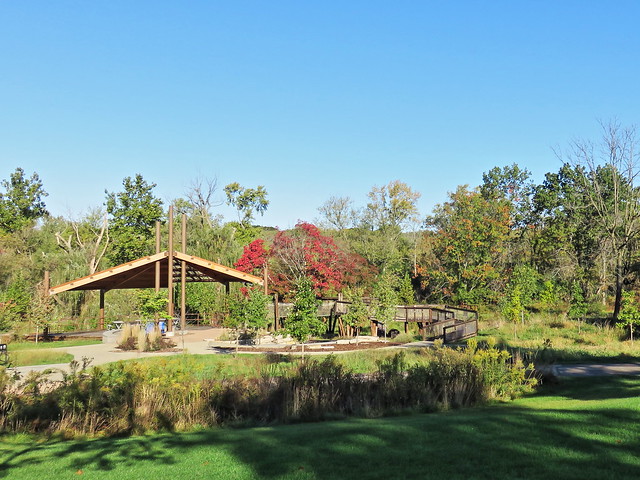
During a break in the rainy weather this past week Mary Lou and I visited Lippold park. Here are a couple of views of the pond and boardwalk:
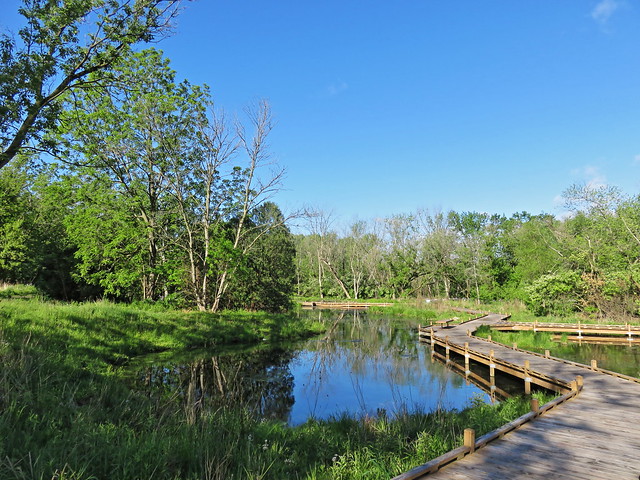
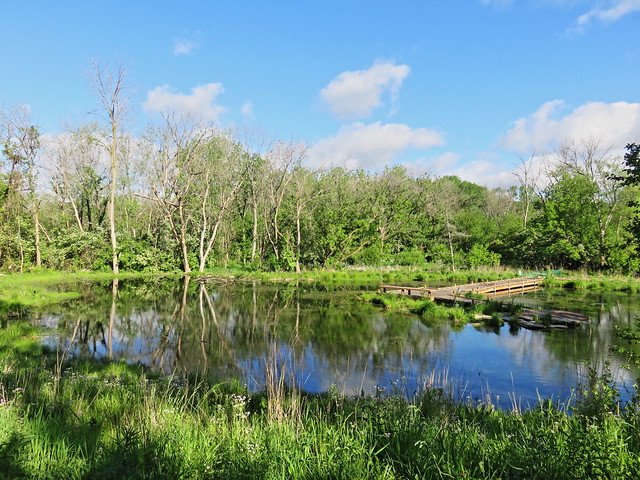
In the fall, Purple Finches visited the cones of one of the tall Bald-cypress trees near the river's edge:
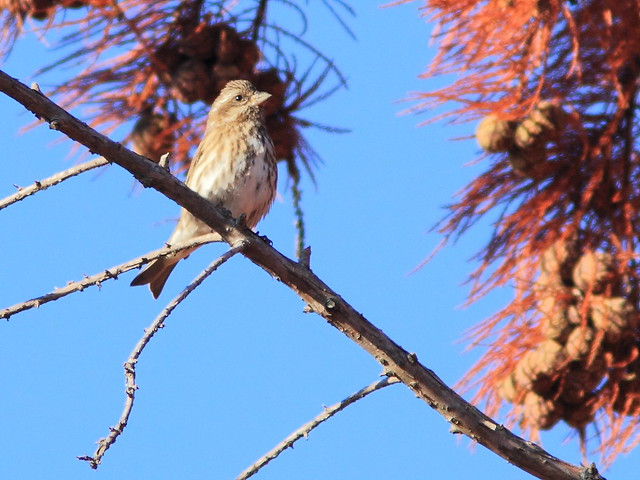
Unlike other conifers, the Bald-cypress trees lose their needles over the winter. Last week they were sprouting fresh green foliage and emerging green cones.
We were surprised to find a small flock of Cedar Waxwings (Bombycilla cedrorum) moving through the green branches of one of the cedars. At first I thought they were finding insects, but then noticed that they were examining the tiny cones...
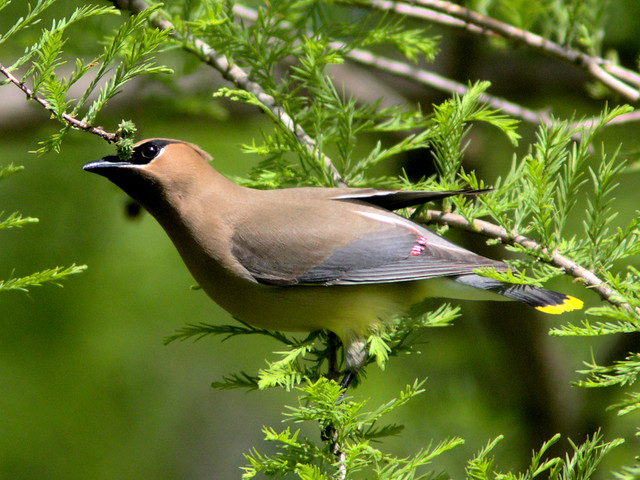
...and plucking them!
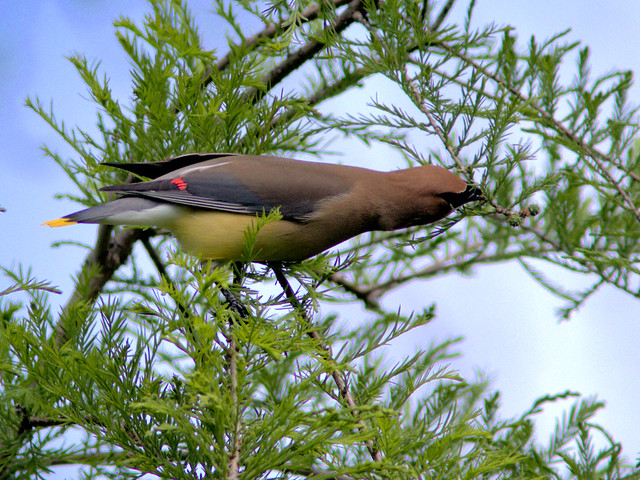
Their actions were acrobatic as they gathered cone buds from the tips of the branches:
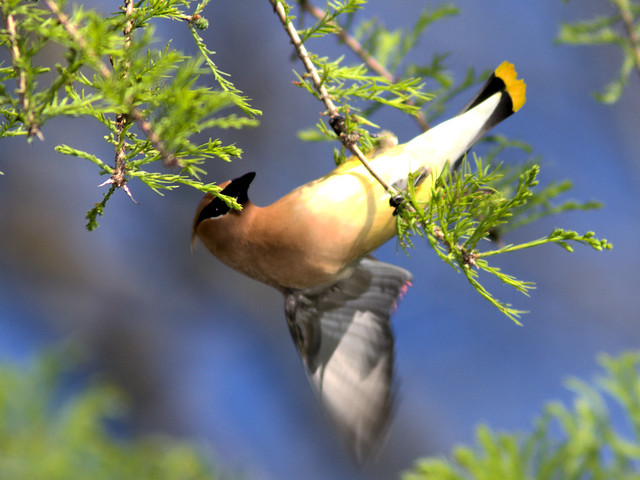
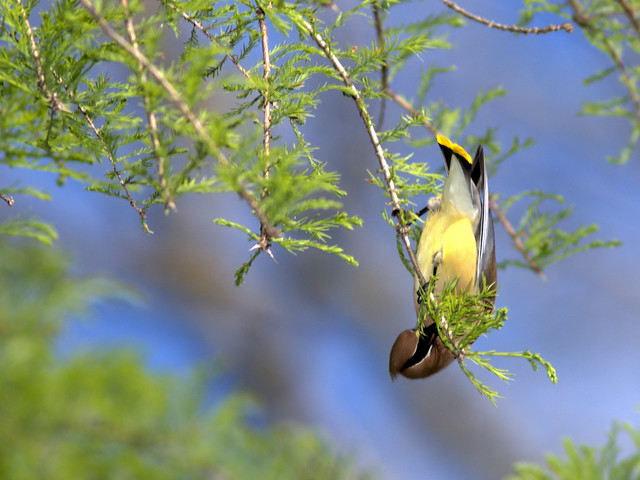
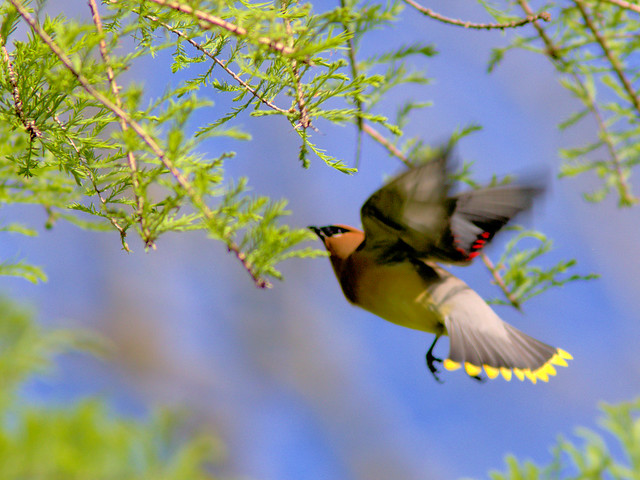
Cedar Waxwings are one of only three members of a family which includes the Bohemian and Japanese Waxwings. The latter is an Asian species and the Bohemian breeds in the far northwestern reaches of Canada into Alaska.
Cedar Waxwings breed all across the northern tier of the US and in southern Canada. They winter south into all of the US, Mexico and Central America. Northernmost birds probably take the place of others which migrate to the south, but their presence can be quite irregular. In Florida we may see large flocks one winter and none at all for most of the next.
Back in Florida, a flock of over 50 Cedar Waxwings seemed to have perfectly synchronized wing-beats (February, 2010):
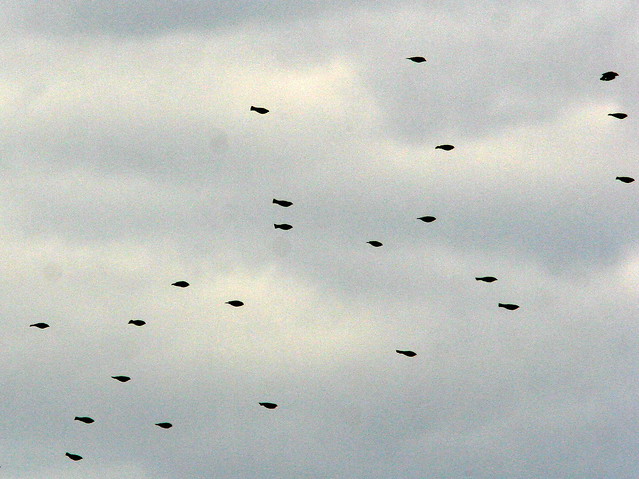
Waxwings get their names from distinctive red wax-like tips on the bare ends their secondary flight feathers. Their diet mainly includes berries, fruit and tree buds, but also many insects. Often they may be seen high in the sky, hawking flying insects in flocks along with swallows. Their habit of eating juniper ("cedar") berries during the winter earned the Cedar Waxwings their first names.
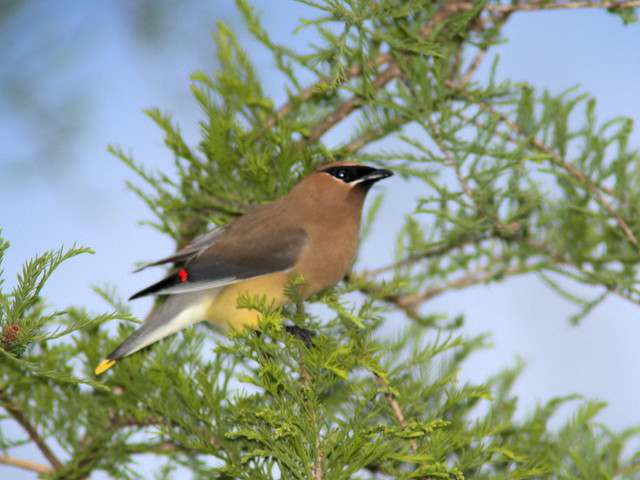
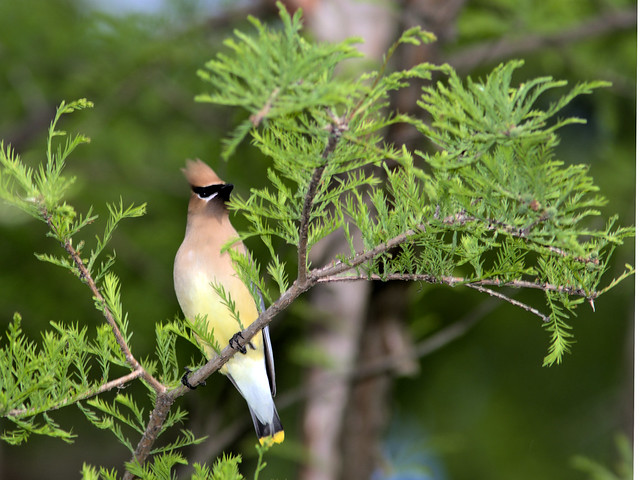
Here are two of my favorite images of the species, both taken at Lippold Park, in May, 2009...

...and in September, 2011:
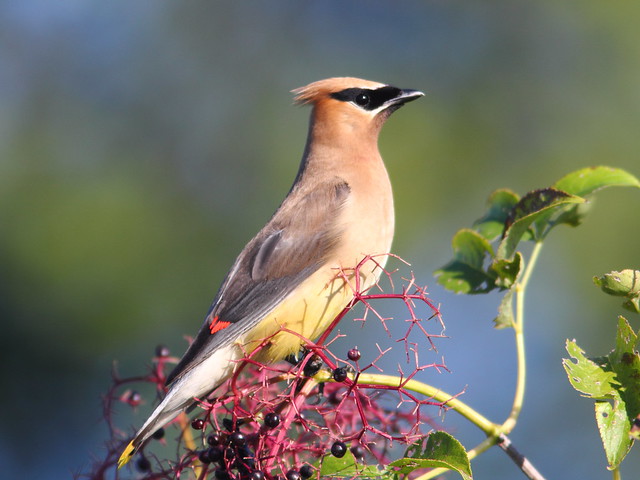
= = = = = = = = = = = = = = =
Linking to Misty's CAMERA CRITTERS,
Linking to Eileen's SATURDAY'S CRITTERS,
Linking to FENCES AROUND THE WORLD by Gosia
Linking to SKYWATCH FRIDAY by Yogi, Sylvia and Sandy
Linking to WEEKEND REFLECTIONS by James
Linking to BirdD'Pot by Anni
Linking to Wild Bird Wednesday by Stewart
Linking to Wordless Wednesday (on Tuesday) by NC Sue
Linking to ALL SEASONS by Jesh
________________________________________________
Please visit the links to all these memes to see some excellent photos on display
________________________________________________
This month's potpourri gathered from the archives features the themes of critters, fences, skies, macros and reflections. It is a retrospective view of photos taken three years ago, in October, 2012. At the time I did not seek to portray each of these memes, so it is a bit of a scavenger hunt. Let's see how far I need to go into the month to find at least one of each. If I can get them all I will have won the game ten months in a row since starting in January, 2015. This month's flashback once again produced the required set of images, but not until the 23rd of the month.
As usual there were plenty of photos of CRITTERS--
My first photo foray into our neighborhood Florida wetlands yielded on October 3, 2012, a nice portrait of a Prairie Warbler:

Two mornings later we encountered an adult Bobcat, sitting in the middle of the gravel road that accesses the wetlands:

Male Black-throated Blue Warbler on October 10:

Fall migration generally provides a greater abundance of colorful warblers than in spring, and 2012 was no exception. This is a Northern Parula, photographed on October 14...

...a Yellow-throated Warbler on October 22:

Halloween Pennant dragonflies, as seen in this MACRO were numerous:

We "reverse migrated" to NE Illinois at the end of October to celebrate a Halloween party and pig roast in honor of our son-in-law's milestone birthday. Rudely thrust into winter-like weather, I did photograph some species for the first time, such as this Purple Finch, on October 25...

...and a Lapland Longspur on the last day of the month:

I would be remiss if I did not include just a couple of more "party critters," yours truly, in costume...

...and unmasked...

...and Cleopatra (Mary Lou)...

flanked by our granddaughters Cinderella (Cari)...

...and the Queen of Hearts (Graci):

My search for REFLECTIONS and SKY photos was productive of many images, such as this Sunrise on October 7 from the back patio of our home:

Paradoxically, this early morning shot on October 8, looking to the southwest over the wetlands seems to portray the sunrise, but the apparently diverging rays are not from the rising sun but rather from the opposite direction (behind my LEFT shoulder)! The rays of the sun filters over the tops of the thunderheads and paints long parallel pink streaks. Perspective gives them the appearance of diverging from the west, but they actually are converging towards the vanishing point. Almost every summer, tropical winds carry dust particles 5,800 miles across the ocean from northern Africa. The dust is able to cross that distance because it travels in its own air layer — the Saharan Air Layer.

I captured another "mirrored sunrise" on October 20, this time directly opposite the rising sun (notice how the clouds are illuminated from the near side rather than from behind):

Saharan dust produced the pink sky that enhanced this view of a Great Egret, on October 26:

At first I thought my search for a photo of a fence in the October 2012 archives was in vain, until I looked closely at this photo of a gathering thunderhead. I was rushing home to beat the storm. It looks back to the gate to the gravel road that leads out of the wetlands. A vehicle is parked just outside the fence, but you must click on the photo to enlarge it:

Fearing that Tex would ban me from her meme for posting the above, I carefully re-reviewed the month's photos and discovered that I had overlooked this October 23 image of a family of Wood Storks gathered on a neighbor's back yard FENCE:





















































